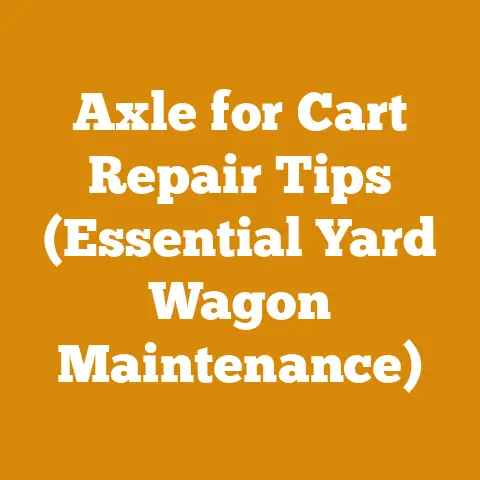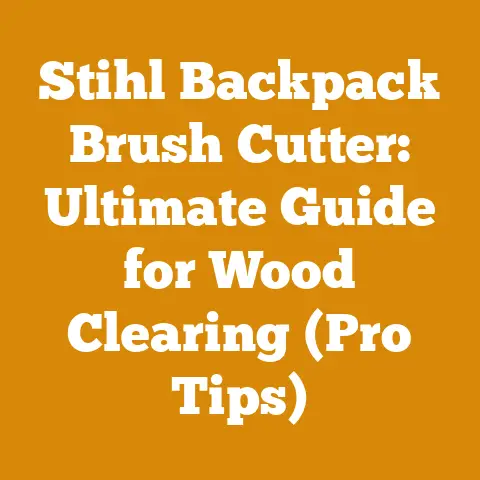Garage Lean-To Addition Floor Tips (Durable Wood & Tool Prep)
Let’s face it, when you’re working with wood, especially in a lean-to attached to your garage, things are bound to get messy. Sawdust, wood chips, the occasional spilled oil – it’s all part of the game. That’s why, when planning the floor for my own garage lean-to addition, ease of cleaning was right up there with durability and tool protection. No one wants to spend more time cleaning than working, right?
Garage Lean-To Addition Floor Tips: Durable Wood & Tool Prep
Building a lean-to onto your garage is a fantastic way to expand your workspace, especially if you’re like me and enjoy woodworking, tinkering with tools, or preparing firewood. But before you jump in and start swinging a hammer, let’s talk about the foundation – literally. Choosing the right floor for your garage lean-to addition is crucial for durability, safety, and overall functionality, especially when you’re dealing with heavy tools and potentially messy wood processing activities. I’ve been there, done that, and learned a few things along the way. So, let’s dive into some tips to help you make the best choice for your needs.
Why the Floor Matters: More Than Just a Surface
Think of your lean-to floor as the unsung hero of your workspace. It’s not just something you walk on; it’s the foundation upon which all your projects rest. A well-chosen floor can:
- Protect Your Tools: A durable surface prevents damage from dropped tools and heavy equipment.
- Enhance Safety: A non-slip surface reduces the risk of accidents, especially when dealing with wet or oily conditions.
- Simplify Cleaning: An easy-to-clean floor saves you time and effort, allowing you to focus on your projects.
- Increase Comfort: A comfortable surface reduces fatigue, especially when standing for long periods.
- Add Value: A well-maintained floor adds value to your property.
I remember one time, I was splitting some particularly knotty oak for firewood in my old workspace (before the lean-to). I had a cheap, thin plywood floor, and when my splitting maul slipped, it went right through the wood and the floor! It was a wake-up call that a proper floor isn’t just a luxury; it’s a necessity.
Let’s break down the most popular choices:
- Solid Wood: Traditional and durable, solid wood flooring offers a classic look and can withstand heavy use. However, it’s susceptible to moisture damage and can be expensive.
- Engineered Wood: Constructed from multiple layers of wood veneer, engineered wood is more stable than solid wood and less prone to warping or cracking. It’s a good compromise between durability and cost.
- Plywood: A budget-friendly option, plywood is strong and versatile. However, it’s not as durable as solid or engineered wood and requires a protective coating to prevent moisture damage.
- Oriented Strand Board (OSB): Similar to plywood, OSB is another affordable option. It’s less expensive than plywood but also less resistant to moisture.
- Reclaimed Wood: Environmentally friendly and full of character, reclaimed wood can add a unique touch to your lean-to. However, it may require extra preparation to ensure it’s clean and structurally sound.
Solid Wood: The Classic Choice
Solid wood flooring is the gold standard for durability and longevity. Think oak, maple, hickory – these hardwoods can take a beating. However, they come with a higher price tag and require careful installation to prevent moisture issues.
Pros:
- Exceptional Durability: Withstands heavy use and impact.
- Timeless Aesthetic: Adds a touch of elegance to your workspace.
- Repairable: Can be sanded and refinished multiple times.
Cons:
- High Cost: More expensive than other wood flooring options.
- Moisture Sensitivity: Prone to warping and cracking in damp environments.
- Installation Complexity: Requires professional installation for best results.
Data Point: According to the National Wood Flooring Association (NWFA), solid wood flooring can last for 100 years or more with proper care and maintenance.
Engineered Wood: The Balanced Approach
Engineered wood flooring offers a sweet spot between durability, cost, and stability. It’s made from layers of wood veneer bonded together, making it less susceptible to moisture damage than solid wood.
Pros:
- Dimensional Stability: Less prone to warping or cracking.
- Cost-Effective: More affordable than solid wood.
- Easy Installation: Can be installed as a floating floor, simplifying the process.
Cons:
- Limited Refinishing: Can only be sanded and refinished a limited number of times.
- Vulnerable to Scratches: The veneer layer can be scratched or damaged by heavy objects.
- Lower Resale Value: Not as desirable as solid wood for resale purposes.
Data Point: A study by the Forest Products Laboratory found that engineered wood flooring is up to 70% more dimensionally stable than solid wood flooring.
Plywood and OSB: The Budget-Friendly Options
Plywood and OSB are the go-to choices for those on a tight budget. They’re strong, versatile, and easy to work with. However, they’re not as durable or moisture-resistant as solid or engineered wood.
Pros:
- Low Cost: The most affordable wood flooring options.
- Easy to Install: Can be easily cut and fastened.
- Versatile: Can be used for a variety of applications.
Cons:
- Low Durability: Prone to damage from impact and moisture.
- Unattractive Appearance: Requires a protective coating to improve aesthetics.
- Limited Lifespan: Will need to be replaced more frequently than other options.
Data Point: According to the Engineered Wood Association (APA), plywood and OSB can provide adequate flooring performance in dry environments with proper installation and maintenance. However, they are not recommended for areas with high moisture exposure.
Reclaimed Wood: The Eco-Conscious Choice
Reclaimed wood is a sustainable and stylish option for your garage lean-to floor. It adds character and charm while reducing your environmental impact.
Pros:
- Unique Appearance: Offers a one-of-a-kind look with natural imperfections.
- Sustainable: Reduces the demand for new wood and conserves resources.
- Durable: Often made from old-growth timber, which is denser and stronger than new wood.
Cons:
- Preparation Required: May need to be cleaned, sanded, and treated to ensure it’s safe and structurally sound.
- Availability: Can be difficult to find and may require sourcing from specialty suppliers.
- Cost: Can be more expensive than new wood, depending on the source and condition.
My Experience with Reclaimed Wood: I once used reclaimed barn wood for a workbench top, and the character it added was incredible. It had nail holes, saw marks, and a beautiful patina that told a story. However, it took a lot of work to clean and stabilize it before I could use it.
Tool Preparation: Protecting Your Investment
Regardless of the wood flooring you choose, proper tool preparation is essential for protecting your investment and ensuring long-term durability. Here are some tips:
- Seal the Wood: Apply a high-quality sealant to protect the wood from moisture, stains, and scratches. Consider using a polyurethane or epoxy sealant for maximum protection.
- Use Floor Mats: Place floor mats under heavy tools and equipment to prevent damage from impact and vibration.
- Install Casters: Equip your workbenches and tool cabinets with casters to make them easier to move and prevent scratches on the floor.
- Clean Regularly: Sweep or vacuum the floor regularly to remove sawdust, dirt, and debris.
- Repair Damage Promptly: Address any cracks, chips, or scratches as soon as possible to prevent further damage.
Sealing the Deal: Choosing the Right Sealant
Choosing the right sealant is crucial for protecting your wood floor. Here’s a breakdown of the most popular options:
- Polyurethane: A durable and water-resistant sealant that provides excellent protection against scratches, stains, and UV damage. It’s a good choice for high-traffic areas.
- Epoxy: A two-part sealant that creates a hard, durable, and chemical-resistant surface. It’s ideal for workshops and garages where spills and chemicals are common.
- Varnish: A traditional sealant that provides a clear, glossy finish. It’s less durable than polyurethane or epoxy but offers a classic look.
- Penetrating Oil: A natural sealant that penetrates the wood fibers, enhancing its natural beauty and providing some protection against moisture. It’s a good choice for those who prefer a matte finish.
Data Point: According to Consumer Reports, polyurethane sealants can last for 5-10 years with proper application and maintenance.
Floor Mats: Your First Line of Defense
Floor mats are an inexpensive way to protect your wood floor from damage. They act as a barrier between your tools and the floor, preventing scratches, dents, and spills.
- Anti-Fatigue Mats: Provide cushioning and reduce fatigue when standing for long periods.
- Rubber Mats: Durable and water-resistant, ideal for areas where spills are common.
- Interlocking Mats: Easy to install and customize to fit your space.
- Toolbox Liners: Prevent tools from sliding and scratching the floor of your toolbox.
My Floor Mat Story: I once dropped a heavy wrench on my unprotected plywood floor, and it left a significant dent. After that, I invested in a set of anti-fatigue mats, and they’ve saved my floor (and my feet) countless times.
Installation Tips: Getting It Right the First Time
Proper installation is essential for ensuring the longevity and performance of your wood floor. Here are some tips to keep in mind:
- Prepare the Subfloor: Ensure the subfloor is level, clean, and dry before installing the wood flooring.
- Acclimate the Wood: Allow the wood to acclimate to the humidity and temperature of the lean-to for several days before installation.
- Use the Right Fasteners: Use appropriate nails, screws, or adhesives for the type of wood flooring you’re installing.
- Leave Expansion Gaps: Leave small gaps around the perimeter of the room to allow for expansion and contraction.
- Follow Manufacturer’s Instructions: Read and follow the manufacturer’s instructions carefully for best results.
Subfloor Preparation: The Foundation of Success
A properly prepared subfloor is crucial for a successful wood flooring installation. Here’s what you need to do:
- Inspect the Subfloor: Check for any cracks, holes, or unevenness.
- Repair Any Damage: Fill any cracks or holes with patching compound and sand down any uneven areas.
- Clean the Subfloor: Remove any dirt, debris, or adhesives.
- Level the Subfloor: Use a self-leveling compound to create a perfectly level surface.
- Install a Moisture Barrier: Install a moisture barrier to protect the wood flooring from moisture damage.
Data Point: According to the NWFA, a properly prepared subfloor can extend the lifespan of a wood floor by up to 25%.
Acclimation: Letting the Wood Breathe
Acclimating the wood to the environment of your lean-to is essential for preventing warping and cracking. Here’s how to do it:
- Store the Wood in the Lean-To: Place the wood flooring in the lean-to for several days before installation.
- Maintain Consistent Temperature and Humidity: Keep the temperature and humidity of the lean-to consistent during the acclimation period.
- Stack the Wood Properly: Stack the wood in a way that allows for air circulation.
- Monitor Moisture Content: Use a moisture meter to monitor the moisture content of the wood.
My Acclimation Mistake: I once rushed a wood flooring installation without properly acclimating the wood, and the result was a disaster. The wood warped and cracked within a few months, and I had to replace the entire floor. Learn from my mistake – don’t skip the acclimation process!
Alternative Flooring Options: Beyond Wood
While wood is a popular choice for garage lean-to floors, it’s not the only option. Here are some alternatives to consider:
- Concrete: Durable, affordable, and easy to maintain, concrete is a popular choice for workshops and garages. However, it can be cold and hard on your feet.
- Epoxy Coating: A seamless and durable coating that protects concrete floors from stains, chemicals, and impact. It’s available in a variety of colors and finishes.
- Rubber Flooring: Provides excellent cushioning and slip resistance, making it a good choice for areas where safety is a concern.
- Tile: Durable and water-resistant, tile is a good choice for areas that are prone to moisture. However, it can be cold and hard on your feet.
Concrete: The Industrial Choice
Concrete is a tough and durable flooring option that can withstand heavy use and abuse. It’s also relatively inexpensive and easy to maintain.
Pros:
- High Durability: Withstands heavy loads and impacts.
- Low Cost: More affordable than wood or tile.
- Easy Maintenance: Can be easily cleaned with a broom or mop.
Cons:
- Cold and Hard: Can be uncomfortable to stand on for long periods.
- Porous: Susceptible to stains and moisture damage.
- Unattractive Appearance: Can look plain and industrial.
Epoxy Coating: The Protective Shield
Epoxy coating is a popular way to protect and enhance concrete floors. It creates a seamless, durable, and chemical-resistant surface that’s easy to clean and maintain.
Pros:
- High Durability: Protects concrete from stains, chemicals, and impact.
- Seamless: Creates a smooth and easy-to-clean surface.
- Variety of Colors and Finishes: Can be customized to match your décor.
Cons:
- Installation Complexity: Requires professional installation for best results.
- Cost: More expensive than concrete alone.
- Can Be Slippery: May require a non-slip additive for safety.
Rubber Flooring: The Comfortable Choice
Rubber flooring provides excellent cushioning and slip resistance, making it a good choice for areas where safety and comfort are a priority.
Pros:
- Comfortable: Provides cushioning and reduces fatigue.
- Slip-Resistant: Reduces the risk of accidents.
- Durable: Withstands heavy use and impact.
Cons:
- Cost: More expensive than concrete or plywood.
- Appearance: May not be as aesthetically pleasing as wood or tile.
- Can Be Difficult to Clean: May require special cleaning products.
Case Studies: Real-World Examples
Let’s take a look at some real-world examples of garage lean-to flooring projects:
- Case Study 1: The Woodworker’s Workshop: A woodworker installed solid maple flooring in his lean-to to create a durable and attractive workspace. He sealed the floor with polyurethane and installed floor mats under his heavy machinery.
- Equipment Used: Solid maple flooring, polyurethane sealant, floor mats, table saw, jointer, planer.
- Wood Type: Maple.
- Safety Considerations: Dust collection system, eye and ear protection.
- Case Study 2: The Mechanic’s Garage: A mechanic coated his concrete lean-to floor with epoxy to protect it from oil and chemical spills. He added a non-slip additive to the epoxy to improve safety.
- Equipment Used: Epoxy coating, non-slip additive, concrete grinder, vacuum cleaner, safety glasses, gloves.
- Wood Type: N/A (Concrete floor).
- Safety Considerations: Proper ventilation, respirator.
- Case Study 3: The Firewood Processor’s Shed: A firewood processor installed plywood flooring in his lean-to to create a budget-friendly and functional workspace. He sealed the plywood with a water-resistant sealant and installed rubber mats to protect the floor from impact.
- Equipment Used: Plywood flooring, water-resistant sealant, rubber mats, chainsaw, log splitter, firewood processor.
- Wood Type: N/A (Plywood floor).
- Safety Considerations: Chainsaw safety gear, hearing protection, eye protection.
Making the Right Choice: A Summary
Choosing the right floor for your garage lean-to addition is a crucial decision that will impact the durability, safety, and functionality of your workspace. Consider your budget, the type of work you’ll be doing, and your personal preferences when making your choice. Remember to prepare the subfloor properly, acclimate the wood, and protect the floor with sealant and floor mats. And don’t forget to prioritize safety!
Here’s a quick recap of the key takeaways:
- Consider your budget: Solid wood is the most expensive option, while plywood and OSB are the most affordable.
- Think about durability: Solid wood and epoxy coating are the most durable options, while plywood and OSB are less durable.
- Prioritize safety: Choose a slip-resistant surface and use floor mats to prevent accidents.
- Prepare the subfloor: A properly prepared subfloor is essential for a successful installation.
- Acclimate the wood: Allow the wood to acclimate to the environment of your lean-to before installation.
- Protect the floor: Seal the floor with a high-quality sealant and use floor mats to prevent damage.
Ultimately, the best floor for your garage lean-to addition is the one that meets your specific needs and budget. Take your time, do your research, and choose wisely. Your feet (and your tools) will thank you for it!






